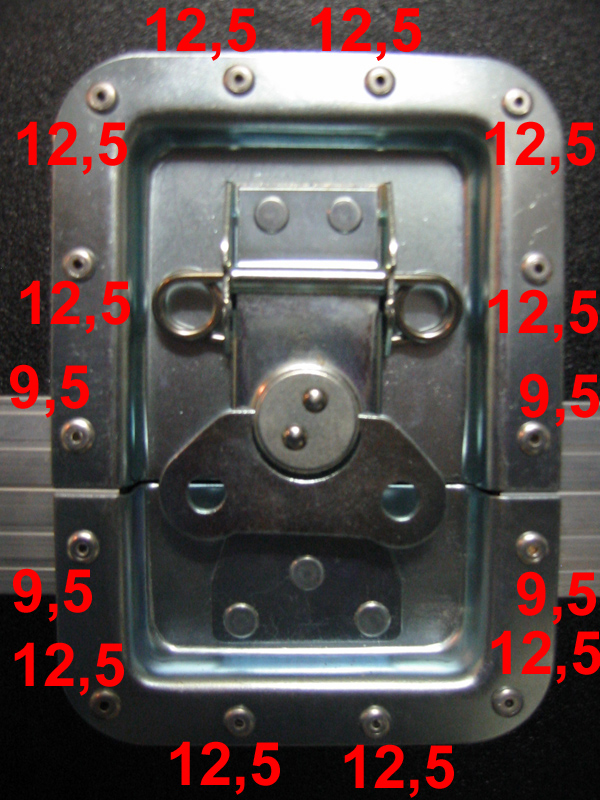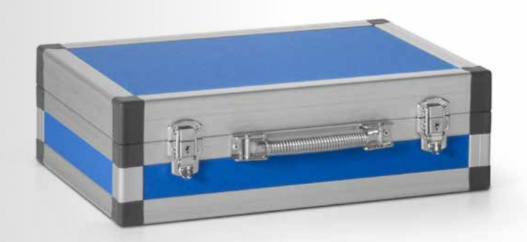Why are there sometimes rivets of different diameters in this table?
What do LT and HD mean in this table?
Can I combine LT and HD in one and the same flight case?
How should I use this table?
How does a rivet actually work?
Can I also build a flight case without rivets?
| Construction method simple case angle profile |
Construction method double casemaker profile |
|||||||||||
| Wood | Wood | Plastic | ||||||||||
| 10 mm | 7 mm | 10 mm | 7 mm | 10 mm | 7 mm | |||||||
| LT | HD | LT | HD | LT | HD | LT | HD | LT | HD | LT | HD | |
| Case angle | 4,0x12,5 4,8x10,5 4,8x15 |
4,8x19,5 | 4,0x9,5 4,0x12,5 4,8x10,5 |
4,8x15 | - | - | - | - | - | - | - | - |
| Casemaker | - | - | - | - | 4,0x9,5 4,0x12,5 4,8x10,5 |
4,8x19,5 | 4,0x9,5 | 4,8x15 | 4,8x12 | 4,8x18 | 4,0x9,5 | 4,8x16 |
| Lid location (*) | - | (**) | - | (**) | - | (**) | - | (**) | - | (**) | - | (**) |
| Large corner brace |
2x(*): 4,0x9,5 4,8x10,5 2x: 4,0x12,5 4,8x10,5 4,8x15 |
2x(*): 4,0x9,5 4,8x10,5 2x: 4,8x19,5 |
2x(*): 4,0x9,5 4,8x10,5 2x: 4,0x12,5 4,8x10,5 |
2x(*): 4,0x9,5 4,8x10,5 2x: 4,8x15 4,8x19,5 |
2x(*): 4,0x9,5 4,8x10,5 2x: 4,0x12,5 4,8x10,5 4,8x15 |
2x(*): 4,0x9,5 4,8x10,5 2x: 4,8x19,5 |
2x(*): 4,0x9,5 4,8x10,5 2x: 4,0x12,5 4,8x10,5 |
2x(*): 4,0x9,5 4,8x10,5 2x: 4,8x15 4,8x19,5 |
2x(*): 4,8x12 2x: 4,8x12 |
2x(*): 4,8x12 2x: 4,8x21 |
2x(*): 4,0x9,5 2x: 4,0x9,5 |
2x(*): 4,0x9,5 2x: 4,8x16 |
| Ball corner | 4,0x12,5 4,8x10,5 4,8x15 |
4,8x19,5 | 4,0x9,5 4,8x10,5 |
4,8x15 | 4,0x12,5 4,8x10,5 4,8x15 |
4,8x19,5 | 4,0x9,5 4,8x10,5 |
4,8x15 | 4,8x12 | 4,8x18 4,8x21 |
4,8x12 | 4,8x16 |
| Recessed butterfly latch and lid stay /hinge |
4x(*): 4,0x9,5 4,8x10,5 rest: 4,0x12,5 4,8x10,5 4,8x15 |
4x(*): 4,0x9,5 4,8x10,5 rest: 4,8x19,5 |
4x(*): 4,0x9,5 4,8x10,5 rest: 4,0x12,5 4,8x10,5 |
4x(*): 4,0x9,5 4,8x10,5 rest: 4,8x15 4,8x19,5 |
4x(*): 4,0x9,5 4,8x10,5 rest: 4,0x12,5 4,8x10,5 4,8x15 |
4x(*): 4,0x9,5 4,8x10,5 rest: 4,8x19,5 |
4x(*): 4,0x9,5 4,8x10,5 rest: 4,0x12,5 4,8x10,5 |
4x(*): 4,0x9,5 4,8x10,5 rest: 4,8x15 4,8x19,5 |
4x(*): 4,8x12 rest: 4,8x12 |
4x(*): 4,8x12 rest: 4,8x21 |
4x(*): 4,0x9,5 rest: 4,0x9,5 |
4x(*): 4,0x9,5 rest: 4,8x16 |
| Recessed handle (***) |
4,0x12,5 4,8x10,5 4,8x15 |
4,8x19,5 | 4,0x9,5 4,0x12,5 4,8x10,5 |
4,8x19,5 | 4,0x12,5 4,8x10,5 4,8x15 |
4,8x19,5 | 4,0x9,5 4,0x12,5 4,8x10,5 |
4,8x19,5 | 4,8x12 | 4,8x21 | 4,8x12 | 4,8x16 |
(*) At Flightcase-brico.com we recommend not securing the closing profiles themselves with rivets. Why? Because we don't like that and because it is often simply not necessary. But both the large corner brace and any recessed butterfly locks and hinges do of course overlap with the lid location. The line in this table therefore concerns those rivets in that overlapping part. If this table states "2x(*)" or "4x(*)", this refers to 2 or 4 rivets that are attached to the lid locations. Below is an example of the construction method with case angle profiles and 10 mm wood:


(**) Not completed because we recommend never drilling through the lid location profile. So look here at the previous column (LT).
(***) To install a medium recessed handle or a large recessed handle in the "HD" construction method, you can use the matching plate for medium built-in handle or ring plate for large built-in handle from Flightcase-brico.com. However, you CANNOT use the plate for the medium built-in handle if you choose 7 mm sheet material, because the medium built-in handle is too thick. An alternative solution is again to use washers with an inner diameter of 5 mm, which you can find in the regular DIY store.
Why are there sometimes rivets of different diameters in this table?
In one cell of this table there are sometimes several options below each other. This means that you can choose yourself. A general rule is: the larger the diameter and/or the longer the rivet, the stronger. Furthermore, the choice can also be based on aesthetic considerations. Some people find rivets with a diameter of 4.8 mm nicer or cooler because of the larger head of the rivet. Are you still in doubt? Rest assured that the top choice will suffice in most cases.
What do LT and HD mean in this table?
LT = Light, HD = Heavy Duty. Within a specific construction method you often have 2 (or even more) different methods for applying rivets: one for light applications (small flight cases with light contents) and one for heavier applications (more sturdier construction, for large flight cases with heavy loads). The bottom line is that you can choose between short rivets that only attach to the sheet material (= Light) or long rivets that also attach to the back (= Heavy Duty). In the latter case you also need something made of metal along the back, where the rivet can grab hold. For example, with a casemaker double profile you already have that. With a medium recessed handle you can use the matching plate for this and with a large built-in handle you can use the matching ring plate. In all other cases you can simply use a washer. Some examples of how a rivet may or may not grip the inside of your flight case
Can I combine LT and HD in one and the same flight case?
Of course! And we even recommend it! For example, we usually recommend the HD version for mounting a built-in handle on your flight case. But in many situations you can build the rest of your flight case as an LT.
How should I use this table?
Don't be put off! It's much simpler than you think. First choose your construction method at the top of the table and then only look at the LT and HD columns of your chosen flight case construction method. Are you not yet sure how you are going to build your flight case? Then let our handy flight case selector guide you.
Once you have made your choice, you only have to look at the 2 columns (LT and HD) of your construction method. Then you can combine from these columns to your heart's content.
An example: I want to build a flight case with an angle profile and 10 mm wooden sheet material. The box may be strong, but will certainly not be overly loaded. So I choose LT and the smallest rivets (each diameter 4.0) because that will certainly be sufficient. I only choose HD for the handles, because there is quite a bit of weight on the handles when you carry the coffin. I want to prevent the rivets from shooting through the wood when carrying the flight case. So this is how I make my choice:
| Construction method simple case angle profile |
||
| Wood | ||
| 10 mm | ||
| LT | HD | |
| Case angle | 4,0x12,5 4,8x10,5 4,8x15 |
4,8x19,5 |
| Casemaker | - | - |
| Lid location (*) |
- | (**) |
| Large corner brace |
2x(*): 4,0x9,5 4,8x10,5 2x: 4,0x12,5 4,8x10,5 4,8x15 |
2x(*): 4,0x9,5 4,8x10,5 2x: 4,8x19,5 |
| Ball corner | 4,0x12,5 4,8x10,5 4,8x15 |
4,8x19,5 |
| Recessed butterfly latch and lid stay /hinge |
4x(*): 4,0x9,5 4,8x10,5 rest: 4,0x12,5 4,8x10,5 4,8x15 |
4x(*): 4,0x9,5 4,8x10,5 rest: 4,8x19,5 |
| Recessed handle (***) |
4,0x12,5 4,8x10,5 4,8x15 |
4,8x19,5 |
Now it's just a matter of calculating exactly how many rivets of each type I will need. For example: for one medium recessed handle I need 10 rivets of 4.8 mm x 19.5 mm. If I provide 4 handles, I will need 40 of those rivets.
Can I also build a flight case without rivets?
Yes! In other words, you can opt to build an easy case instead of a real flight case. Then you don't need any rivets (or at least not many).

